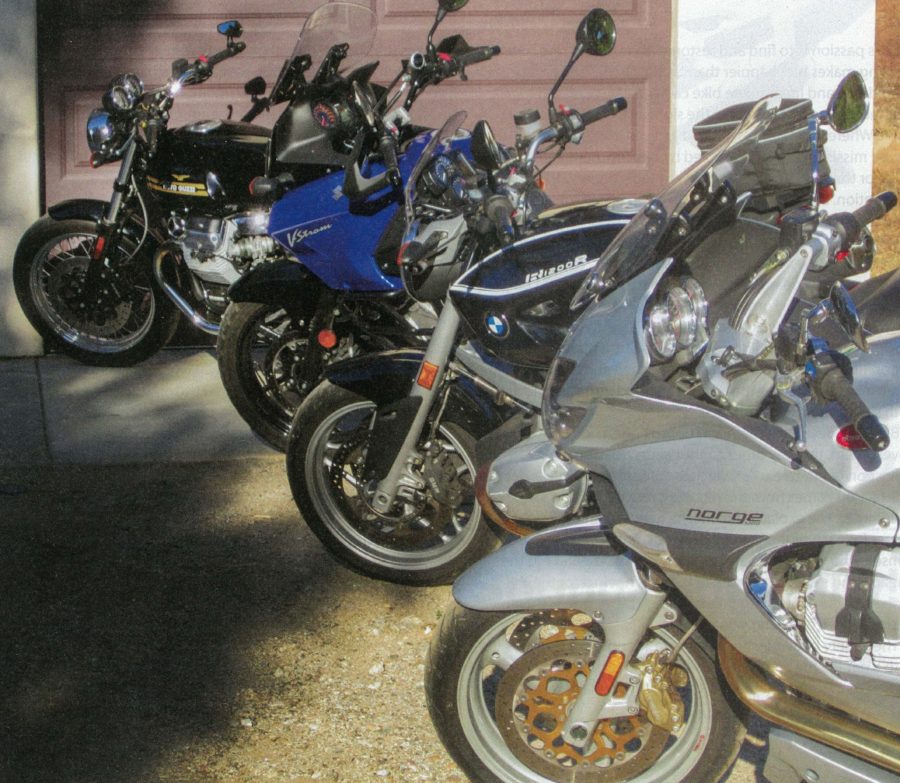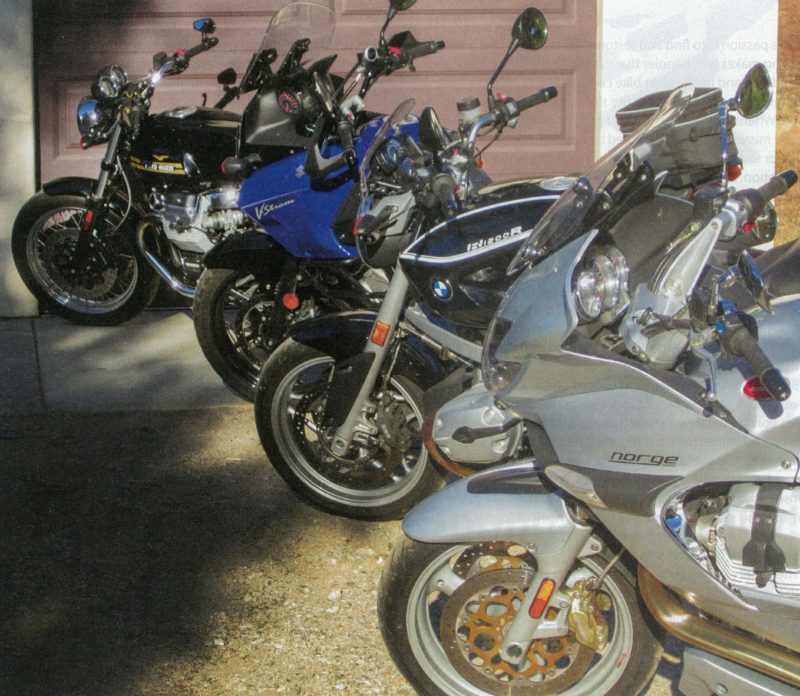By Stuart A. Kirk

“How many bikes are enough?” asked Bob, my philosopher friend, one morning as we were eating donuts at the Santa Fe BMW dealership. It seemed like a straight-forward query, but I had no answer. I recalled later that philosophers raise seemingly simple questions that don’t have obvious answers. The question is complicated: how many simultaneously or sequentially, over a decade, in a lifetime?
I returned to motorcycling 28 years ago after an absence of several decades, and since that time, have been riding 20,000 miles a year on 36 (gulp) different bikes. If I had owned only one bike at a time, that would mean a different bike every nine months over those 28 years. Even to me, that would be an unseemly shuffling of motos, akin to a life of speed dating in which you don’t get to know anyone well or ever have to take anyone to dinner. If, however, you maintain four bikes simultaneously for 28 years, you would only need to replace each of the four bikes every 35 months to accumulate a total of 36.
There are practical advantages to owning more than one bike at a time, including owning different bikes for off-road, touring, sport-riding, two-up riding, track days, etc. When I explain this to my spouse, she raises her eyebrows, rolls her eyes and smiles, conveying that she isn’t convinced, but that I can do whatever I want. I appreciate her indulgence.
My dominant pattern is to own two or three motorcycles at the same time. Typically, I’ve kept them for several years, depending on the strength of my moto buying frenzies, which probably fall more into categories of psychiatry. Just once, after building a separate moto garage, I encountered nature’s abhorrence of a vacuum and briefly filled it with five. Then, when I retired and moved to New Mexico, I lost that extra garage space and needed to stuff three motos and two cars into a two-car garage, something that looks like how I feel after the gluttony of a Thanksgiving dinner.
Every rider has their idiosyncrasies which depend on resources, the centrality of motorcycling in their lives, and the ability to control their desires. Just among the riders I know well, there is vast and interesting diversity of ownership patterns.
Buy One and Hold
Rob acquired a nearly new BMW K 75 Sin 1992. For years it was his only bike. He picked up two other used motorcycles over time, but they were later sold. The high mileage three-cylinder K 75 S remains in largely stock condition. It’s an all-purpose, street/ highway bike that Rob has developed an attachment to, and he rides it around town for errands.
Wear Out One at a Time
Harry was basically a one-bike-at-a-time rider, a very serious rider into his late 80s and a BMW MOA recognized million-miler. On any weekend, if he wasn’t at the Rock Store in the Santa Monica Mountains, he was probably in Minnesota or Alaska. No one ever knew for sure. But one thing was certain, he was riding alone on a late model GS, piling on 100,000 miles every couple of years and would then trade it for a new GS. For this serious, long-distance rider, one well-used bike at a time was enough.
Collector
Before he developed a taste for BMWs, David owned a small group of exquisite Italian bikes (e.g., Moto Guzzi Daytona). His daily rides also tended to be Italian, like a one-of-a-kind Ducati ST4 that I acquired when he moved on to another daily ride. His other Ducatis, such as a rare 1969 350SCR (now residing in the Talbott Motorcycle Museum), infrequently left his garage or living room. They were meticulously maintained, museum quality acquisitions, and he delighted in showing them to friends who could appreciate his passion. For him, a few pristine gems, rarely ridden or seen, was his satisfying stable, although he maintained at least one motorcycle for his extensive traveling.
The First with the Latest
When I lived in Los Angeles-a hotbed of motorcycling-I rode early weekend mornings to the Rock Store. One of the pleasures of that scene was the diversity of the motorcycles that appeared, from museum worthy antiques to the latest Harley cruisers and fastest sport bikes. It was a showplace, where you might see new models th,at were being tested by motojournalists before pictures of the new bikes had even appeared in the moto magazines. Part of that showcase was provided by my friend, John, who would regularly be the first to bring a new model that nearly no one had yet seen. John was eclectic; he might show up on a new BMW, Ducati, Honda or Harley. Instead of going to dealers to see the latest exotic model, we’d just wait for John to show up on one. He did not develop an enduring attachment to any bike and didn’t keep them for long. He was a serial short-term owner, getting pleasure from being the “first” and stimulating a parking lot discussion about the aesthetic and engineering merits of his latest acquisition.
Restorer and Guardian
Lee has been an avid rider for 60 years. His collection of motorcycles is the result of his love of older, European bikes. He is a master mechanic by trade, a bike lover and a restorer. He keeps about five motorcycles licensed and insured, which he rides regularly, but his garage and side porch are stuffed with several dozen more.
Lee’s passion is to find and restore old classics or rare bikes. Nothing makes him happier than to find an old, abandoned, dilapidated and incomplete bike carcass leaning against a tree in someone’s yard. The sorrier the sight, the greater his excitement. Where everyone else would just see junk, Lee finds a sacred mission. He is not troubled by missing, bent or broken parts, or the complete absence of any legal paperwork or registration. Lee’s passion is to clean them up and get them running again. Old Ducatis, Moto Guzzis, BMWs, etc-every bike is completely dismantled and returned to running order. Most need a new battery, plugs, fluids, tires, etc. Months of work are spent finding parts, making parts, substituting parts from other goners. Some are Frankenstein remakes, some are nearly completely stock, and some are elegantly customized. Few of these bikes would be considered authentic antique restorations. Nevertheless, once refurbished and running-a small miracle in itself-the bike is squeezed into a room packed with similar completed projects.
But Lee doesn’t sell them and doesn’t often ride them. Lee covets them, the way other connoisseurs treasure their collection of art, rare wrist watches or fountain pens. His deep satisfaction comes from the recovery, restoration and safe keeping. As Lee explained to me, he needs to find the right owner for each of them. In other words, find someone like himself who will appreciate the rarity of the bike and has the passion and skills to take care of it. Lee is not in it for the money, but for the experience of being able to give life to an unusual piece of motorcycle history.
The variety of ownership idiosyncrasies goes on: the guys with a garage full of dirt bikes, owners with eclectic tastes who owned many different brands, riders with several task-specific bikes (off-road, touring, sport), and former enthusiasts who may still own several bikes, but none of them have been ridden often or are even in running condition.
Professor Bob’s “How many is enough?” may not have an answer. We are all different and our preferences change, frequently for some, rarely for others. Many factors influence ownership, such as space, time to ride and tinker, and the opinions of the spouse. We also have our own peculiarities: the emotional bonds with a specific bike, the attraction to the latest or oldest technologies, and the personal level of enjoyment in owning and riding. Does owning more motorcycles at the same time or in sequence produce more enjoyment or miles ridden? Probably not for most riders. More motos, however counted, is not necessarily better.
Here is what I think is essential: Do you own a motorcycle that is attractive to you, that excites you when you throw a leg over the saddle and rest your hands on the grips, that increases your pulse when the engine rumbles to life? Do you own a motorcycle that magically improves your mood as you begin to roll down your street, that helps you forget your worries temporarily, and that gives you a sense of mastery and well-being as you accelerate through that first set of curves on your favorite twisty road?
How many? Only one, if you love it.
Stuart Kirk’s recent book, Revved! Obsessions of a Midlife Motorcyclist (available from Amazon) describes his immersion into motorcycling. A retired professor, he now lives in Santa Fe and rides a web of extraordinary mountain and canyon roads. Published in the December 2019 BMW Owners News magazine.

